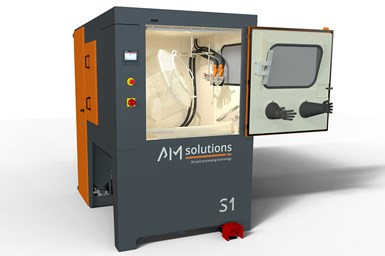AM Solutions Updates S1 Postprocessing for Depowdering
System ensures postprocessing tasks are handled more efficiently, safer and more consistently.
Share

AM Solutions’ redesigned S1 surface treatment system
AM Solutions, a division of the Rösler group, has redesigned its S1 surface treatment system for the automatic depowdering and cleaning of small to midsize volumes of 3D-printed plastic components. This plug-and-play unit’s technical features are designed to ensure more consistent results, higher efficiency and cleaner workpieces.
The machine design enables an easy switch from automatic to manual operation without time-consuming retooling. The operator simply unlocks the rotary basket and moves it to the rear of the blast cabinet. This provides work space for the manual handling and blasting of somewhat larger components, and ensures that the operator is not exposed to any moving parts.
The integrated rotary basket enables the fully automatic processing of batches up to 25 L and a maximum batch weight of 50 kg. The basket is designed to ensure the optimal distribution and mixing of the components during the blast operation. This, in combination with the pivoting blast nozzles, is said to guarantee the effective and gentle blast treatment of the components in short cycle times. Once the blast cycle is complete, the blast nozzles are automatically swiveled out of the basket to prevent any powder accumulated on the blast nozzle holder to fall back into the basket and recontaminate the cleaned components during the subsequent shakeout.
For loading and unloading, the basket swivels to the large opening in the cabin front but remains completely within the blast chamber. This enables the ergonomic loading and unloading of workpieces without the risk of contaminating the immediate machine environment with powder.
The inside of the cabinet and rotary basket are both lined with an antistatic polyurethane coating. The precisely defined shore hardness of the basket lining prevents any color contamination of the workpieces. Also, the system utilizes components (such as motors and valves) that are in compliance with ATEX standards.
Related Content
-
Solukon’s Metal Powder Collection Unit Offers Simple, Safe Material Handling
With the SFM-PCU integrated into the additive manufacturing system, users no longer have direct contact with the powder material during depowdering — the powder remains in a closed system at all times.
-
Enhanced Digital Factory Tool Quantifies Carbon Footprint of Automated Depowdering
Solukon has enhanced its Digital Factory Tool, which integrates additive manufacturing automation and quality assurance, giving the sensor and interface kit a more comprehensive transparency in automated depowdering.
-
Hawk Ridge Systems and DyeMansion Forge Partnership to Integrate Software and Hardware in Additive Manufacturing Workflow
Collaboration creates a one-stop-shop for all the tools and software needed to create precision products that look, feel and function properly. Now, Hawk Ridge Systems’ integrated solution portfolio will include a complete print-to-product workflow with DyeMansion’s Powershot C, Powershot S, DM60 and Powerfuse S postprocessing solutions.














